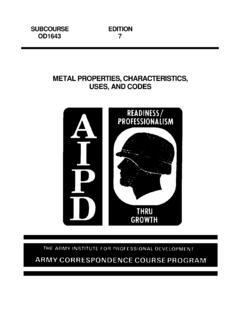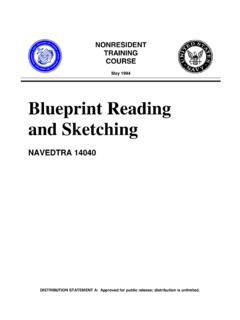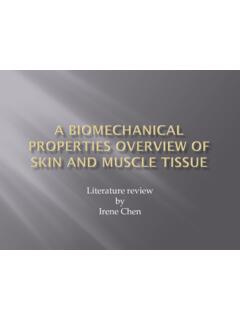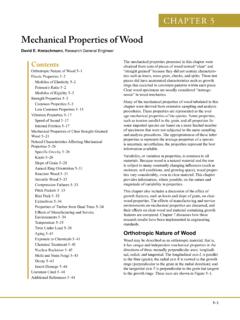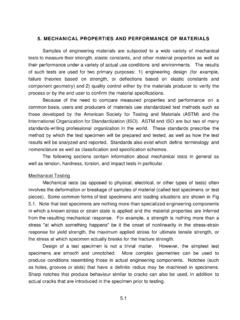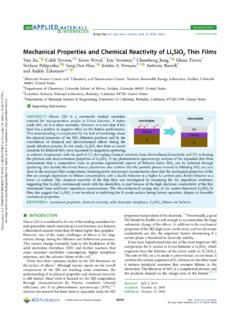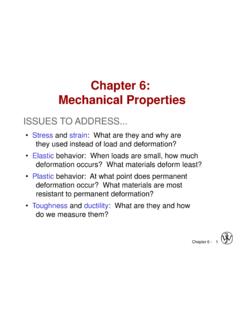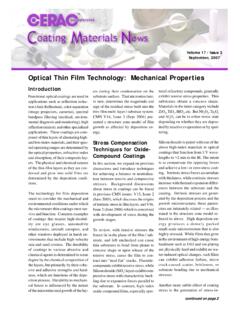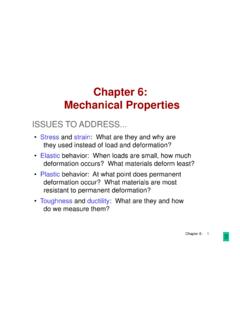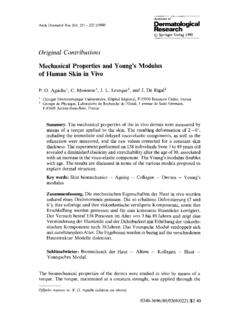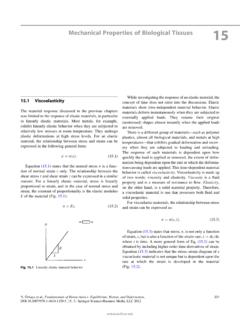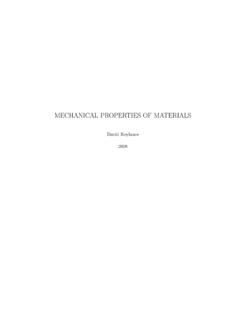Transcription of Heat Treatment and Properties of Iron and Steel
1 UNITED STATES DEPARTMENT OF COMMERCE John T. Connor, Secretary NATIONAL BUREAU OF STANDARDS A. V. Astin, Director r heat Treatment and Properties of iron and Steel Thomas G. Digges, Samuel J. Rosenberg, and Glenn W. Geil DISTRIBUTION STATEMENT A Approved for Public Release Distribution Unlimited National Bureau of Standards Monograph 88 Issued November 1, 1966 Supersedes Circular 495 and Monograph 18 For sale by the Superintendent of Documents, Government Printing Office, Washington, 20402 - Price 35 cents "7 " " s , Contents ! i'! 1. Introduction i g. 2. Properties of iron i Transformation temperatures 1 mechanical Properties 2 3. Alloys of iron and carbon 2 iron -carbon phase diagram 2 Correlation of mechanical Properties with microstructures of slowly cooled 9.
2 Carbon steels 6 4. Decomposition of austenite 6 Isothermal transformation 7 a. To pearlite 7 b. To bainite 7 10. c. To martensite 7 Continuous cooling 8 5. heat Treatment of steels 9 Annealing ~ 10 a. Full annealing I__ 10 b. Process annealing 10 c. Spheroidizing . 10 Normalizing 10 Hardening n a. Effect of mass I__ 11 Tempering n Case hardening 14 a. Carburizing 14 n, b. Cyaniding ~ i c. Carbonitriding 16 d. Nitriding : IQ Surface hardening 17 a. Induction hardening 17 b. Flame hardening 17 Special treatments 17 a. Austempering 17 b. Martempering ~ 18 c. Cold Treatment Z 18 d. Ausforming 18 6. Hardenability ig 7. heat Treatment of cast irons 20 Relieving residual stresses (aging) 20 Annealing 20 a.
3 Malleabilizing ~ 22 Normalizing, quenching, and tempering- 22 Special heat treatments 22 12. Practical considerations 22 Furnaces and salt baths 23 a. Protective atmospheres 23 b. Temperature measurement and control 23 Quenching media and accessories 24 Relation of design to heat Treatment 25 Nomenclature and chemical compositions of steels 26 Structural steels 26 Tool steels I 31 Stainless and heat resisting steels 32 Recommended heat treatments 34 Structural steels 34 Tool steels 35 Stainless and heat resisting steels 35 a. Group I Hardenable chromium steels (martensitic and mag- netic) 38 b. Group II Nonhardenable chro- mium steels (ferritic and mag- netic) 38 c.
4 Group III Nonhardenable chro- mium-nickel and chromium- nickel-manganese steels (aus- tenitic and nonmagnetic) 38 Properties and uses of steels i 38 Structural steels 38 a. Plain carbon structural steels 38 b. Alloy structural steels 39 Tool steels 39 Stainless and heat resisting steels 40 a. Group I Hardenable chromium steels (martensitic and mag- netic) 1 41 b. Group II Nonhardenable chro- mium steels (ferritic and mag- netic) 41 c. Group III Nonhardenable chro- mium-nickel and chromium- nickel-manganese steels (aus- stenitic and nonmagnetic) 41 d. Precipitation-hardenable stainless steels 42 Nickel maraging steels 44 Selected references 45 Library of Congress Catalog Card No.
5 66-61523 heat Treatment and Properties of iron and Steel Thomas G. Digges,1 Samuel J. Rosenberg,1 and Glenn W. Geil This Monograph is a revision of the previous NBS Monograph 18. Its purpose is to provide an understanding of the heat Treatment of iron and steels, principally to those unacquainted with this subject. The basic principles involved in the heat treat- ment of these materials are presented in simplified form. General heat Treatment procedures are given for annealing, normalizing, hardening, tempering, case hardening, surface hardening, and special treatments such as austempenng, ausforming, mar- tempering and cold Treatment . Chemical compositions, heat treatments, and some Properties and uses are presented for structural steels, tool steels, stainless and heat - resisting steels, precipitation-hardenable stainless steels and nickel-maraging steels.
6 1. Introduction The National Bureau of Standards receives many requests for general information con- cerning the heat Treatment of iron and Steel and for directions and explanations of such processes. This Monograph has been prepared to answer such inquiries and to give in simpli- fied form a working knowledge of the basic theoretical and practical principles involved in the heat Treatment of iron and Steel . The effects of various treatments on the structures and mechanical Properties of these materials are described. Many theoretical aspects are discussed only briefly or omitted entirely, and in some instances, technical details have been neglected for simplicity. The present Mono- graph supersedes Circular 495, which was pub- lished in 1950, and Monograph 18 (1960).
7 heat Treatment may be defined as an opera- tion or combination of operations that involves the heating and cooling of a solid metal or alloy for the purpose of obtaining certain desirable conditions or Properties . It is usually desired to preserve, as nearly as possible, the form, dimensions, and surface of the piece being treated. Steels and cast irons are essentially alloys of iron and carbon, modified by the presence of other elements. Steel may be defined as an alloy of iron and carbon (with or without other alloying elements) containing less than about percent of carbon, usefully malleable or forgeable as initially cast. Cast iron may be defined as an alloy of iron and carbon (with or without other alloying elements) containing more than percent of carbon, not usually malleable or forgeable as initially cast.
8 For reasons that will be apparent later, the divid- ing line between steels and cast irons is taken at percent of carbon, even though certain special steels contain carbon in excess of this amount. In addition to carbon, four other elements are normally present in steels and in cast irons. These are manganese, silicon, phosphorus, and sulfur. Steels may be broadly classified into two types, (1) carbon and (2) alloy. Carbon steels owe their Properties chiefly to the carbon. They are frequently called straight or plain carbon steels. Alloy steels are those to which one or more alloying elements are added in suf- ficient amounts to modify certain Properties . The Properties of cast iron also may be modi- fied by the presence of alloying elements such irons are called alloy cast irons.
9 2. Properties of iron Since iron is the basic element of Steel , a knowledge of some of its Properties is a pre- requisite to an understanding of the funda- mental principles underlying the heat Treatment of steels. Transformation Temperatures If a molten sample of pure iron were allowed to cool slowly and the temperature of the iron were measured at regular intervals, an ideal- 1 Retired. ized (equilibrium) time-temperature plot of the data would appear as shown in figure 1. The discontinuities (temperature arrests) in this curve are caused by physical changes in the iron . The first arrest at 2,800 F marks the tem- perature at which the iron freezes. The other arrests (known as transformation tempera- tures or critical points) mark temperatures at which certain internal changes take place in the solid iron .
10 Some of these temperatures are very important in the heat Treatment of Steel . 2800 2550 Id <r (E UI Q. 5 1670 1420 V LIQUID -' r^. MELTING POINT r \ ]__ \ Xs ^2 a ^v TIME FIGURE 1. Idealized cooling curve for pure iron . The atoms in all solid metals are arranged in some definite geometric (or crystallographic) pattern. The atoms in iron , immediately after freezing, are arranged in what is termed the body-centered cubic system. In this crystal structure the unit cell consists of a cube with an iron atom at each of the eight corners and another in the center (fig. 2, a). Each of the many individual grains (crystals) of which the solid metal is composed is built up of a very large number of these unit cells, all ori- ented alike in the same grain.)
